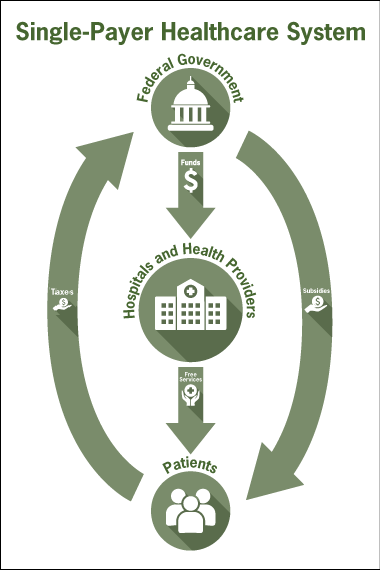Table of ContentsThe 7-Minute Rule for The Role Of Public Policy In Health Care Market Change ...The smart Trick of The Role Of Public Policy In Health Care Market Change ... That Nobody is Discussing

Appendix B provides some texture to this aggregate analysis by examining the prospective crowd-out of cash salaries by increasing ESI premiums across wage fifths (what does a health care administration do). The increase in costs on public health protection originates from rising per-enrollee costs of this protection combined with a boost in the population covered by public insurance.
We offer a broad procedure of this "excess expense" in Figure Bthe development rate of health costs per capita minus the growth rate of potential GDP per capita. For, we use the excess growth rates calculated by the Congressional Budget Plan Office (CBO) specifically for the general public programs. CBO measures take into account demographic modifications within the public programs that may have influenced costs.
The figure shows that public spending as a share of GDP in 2016 would have been 1.3 percentage pointsor more than $250 billionlower had actually there been no excess cost development in public insurance programs over that time duration. Year Real No excess cost growth 1987 2.7% 2.7% 1988 2.7% 2.7% 1989 2.9% 2.8% 1990 3.1% 2.9% 1991 3.5% 3.1% 1992 3.7% 3.2% 1993 4.0% 3.3% 1994 4.1% 3.3% 1995 4.3% 3.4% 1996 4.3% 3.3% 1997 4.3% 3.2% 1998 4.2% 3.2% 1999 4.1% 3.3% 2000 4.2% 3.4% 2001 4.5% 3.6% 2002 4.7% 3.9% 2003 4.8% 4.0% 2004 5.0% 4.0% 2005 5.0% 4.0% 2006 5.2% 4.0% 2007 5.3% 4.0% 2008 5.6% 4.2% 2009 6.1% 4.5% 2010 6.2% 4.6% 2011 6.2% 4.7% 2012 6.2% 4.8% 2013 6.3% 4.9% 2014 6.5% 5.1% 2015 6.7% 5.2% 2016 6.7% 5.4% ChartData Download information The information underlying the figure.
Possible GDP is a measure of what GDP might be as long as the economy did not struggle with excess unemployment. The difference between the development Click for more info rate of possible GDP per capita and health spending per capita is frequently explained as "excess expense growth" in health care. Potential GDP is used http://titusatwj001.yousher.com/h1-style-clear-both-id-content-section-0-getting-my-health-care-policy-jama-network-to-work-h1 to determine excess healthcare cost growth so that it is not contaminated by financial recessions and booms.
However this past performance may downplay potential future pressures from health care expense growth. The 30 to 40 years ending in 2016 that saw prevalent excess health care development saw these costs start from a much more modest base. Going forward from today, rates of excess health care cost growth in line with the historical averages over the past 40 years would put rapid and large pressure on Americans' earnings offered for nonhealth intake.
In the first circumstance, excess cost development follows the path anticipated by the CBO long-term budget outlook for public programs. For employer-paid ESI premiums, we utilize the projection of the Social Security Administration (SSA) about the pace of decline in the ratio of profits to overall settlement, a decrease that SSA attributes entirely to the increasing expense of healthcare (SSA 2018).
The Facts About Health Care Policy - Jama Network Uncovered
Under the existing projections course, spending on public programs and by employers on ESI premiums reaches 18.1 percent of GDP by 2048, but without excess cost development, it reaches only 15 (how to take care of your mental health).6 percent of GDP. The 2.5 percentage-point distinction suggested by these divergent courses would suggest almost $500 billion in extra resources in today's dollars.
After the child boomers are soaked up into Medicare, the upward pressure on health costs coming from pure demographics is expected to slow considerably, and excess cost growth ends up being practically the sole explainer of patterns thereafter. Projected No excess expense development 2018 13.3654% 13.3654% 2019 13.3653% 13.3654% 2020 13 (what is home health care).4911% 13.4654% 2021 13.7170% 13.6654% 2022 14.0429% 13.9654% 2023 14.1687% 14.0654% 2024 14.0945% 13.9654% 2025 14.4203% 14.2654% 2026 14.6461% 14.4654% 2027 14.7719% 14.5654% 2028 15.0977% 14.8654% 2029 15.1234% 14.7654% 2030 15.2492% 14.7654% 2031 15.5749% 14.9654% 2032 15.7006% 15.0654% 2033 15.8263% 15.0654% 2034 16.0519% 15.1654% 2035 16.1776% 15.1654% 2036 16.4032% 15.2654% 2037 Find more info 16.5288% 15.2654% 2038 16.6545% 15.3654% 2039 16.8801% 15.3654% 2040 17.0056% 15.3654% 2041 17.2312% 15.3654% 2042 17.2567% 15.3654% 2043 17.4823% 15.3654% 2044 17.6078% 15.4654% 2045 17.7333% 15.5654% 2046 17.8588% 15.5654% 2047 17.9842% 15.5654% 2048 18.1097% 15.5654% ChartData Download data The data underlying the figure.